Looking for a new walking backpack to take with you on day hikes? We've tried and tested a selection of hiking backpacks to find the best. Whether you're looking for a neat, lightweight design to store your lunch and waterproof gear on a casual ramble, or a larger piece of kit for a more serious hike, our guide has got you covered.
How to choose the right hiking backpack
When picking a hiking daypack, there are a number of key factors you need to consider, including capacity, fit, ventilation, comfort and additional safety features. Skip to our buyers' guide for our complete guide to finding the right hiking backpack for you.
SQUIRREL_PLAYLIST_10126805
Edited 24/10/24 to reflect stock availability and current pricing.
Best hiking backpacks reviewed in 2025
Tested and reviewed by Rob Slade
Lowe Alpine AirZone Trek 28L
SQUIRREL_TEXT_13077028
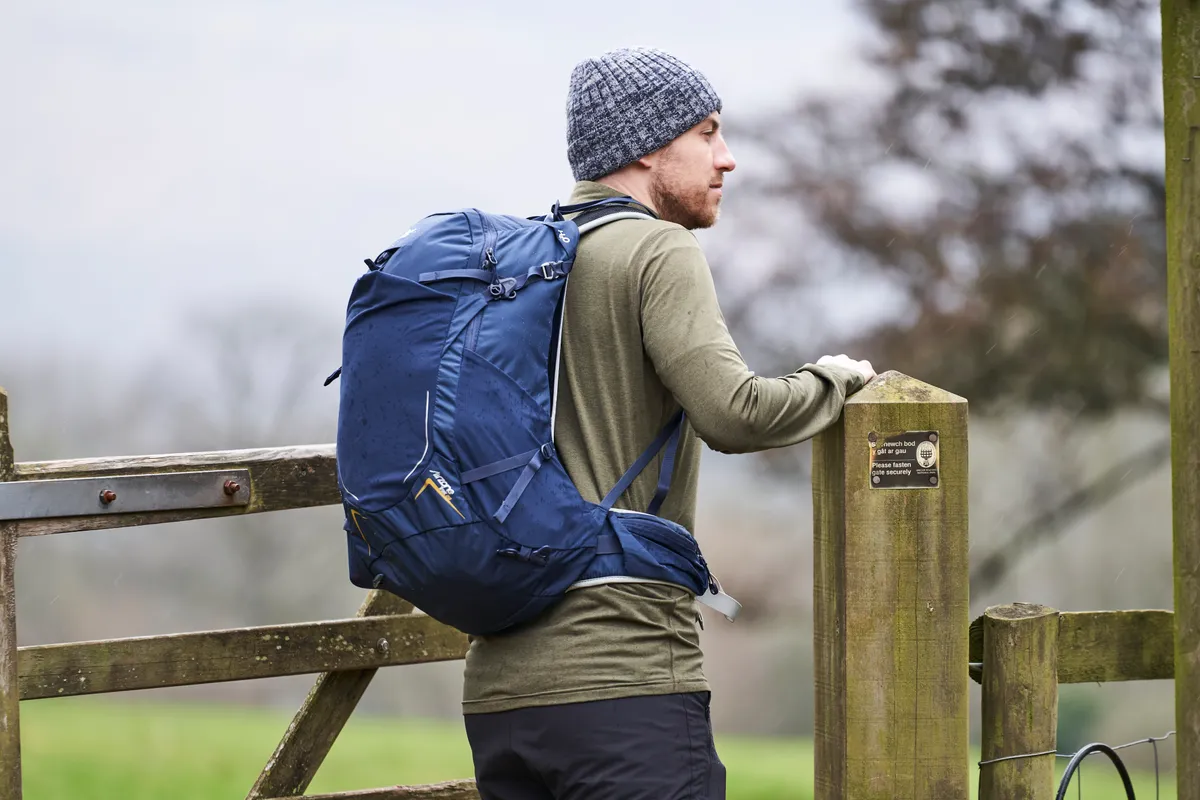
- Rain cover? Yes
- Hydration bladder compatible? Yes
- Hiking pole attachments? Yes
- Whistle? Yes, on sternum strap
- Weight: 1,300g
Having impressed us during testing, the Lowe Alpine AirZone Trek has earned a five-star rating here. In fact, it was hard to find fault with this pack – even after we put it through its paces on Moel Siabod and Moel Hebog in North Wales.
While the pack is slightly heavier than others at 1.3kg, the back harness and hip belt help to even out any weight. We liked the adjustable, trampoline-style back panel, which stops you getting too sweaty during tough stretches, and all the extra touches like the zip-up pocket on the hip belt and the in-built sternum strap whistle.
Pros: Highly comfortable, adjustable back harness, fantastic feature list
Cons: Heavier than some other options
Read our full review of the Lowe Alpine AirZone Trek 28L
SQUIRREL_13077028
Deuter Trail 30
SQUIRREL_TEXT_13077026
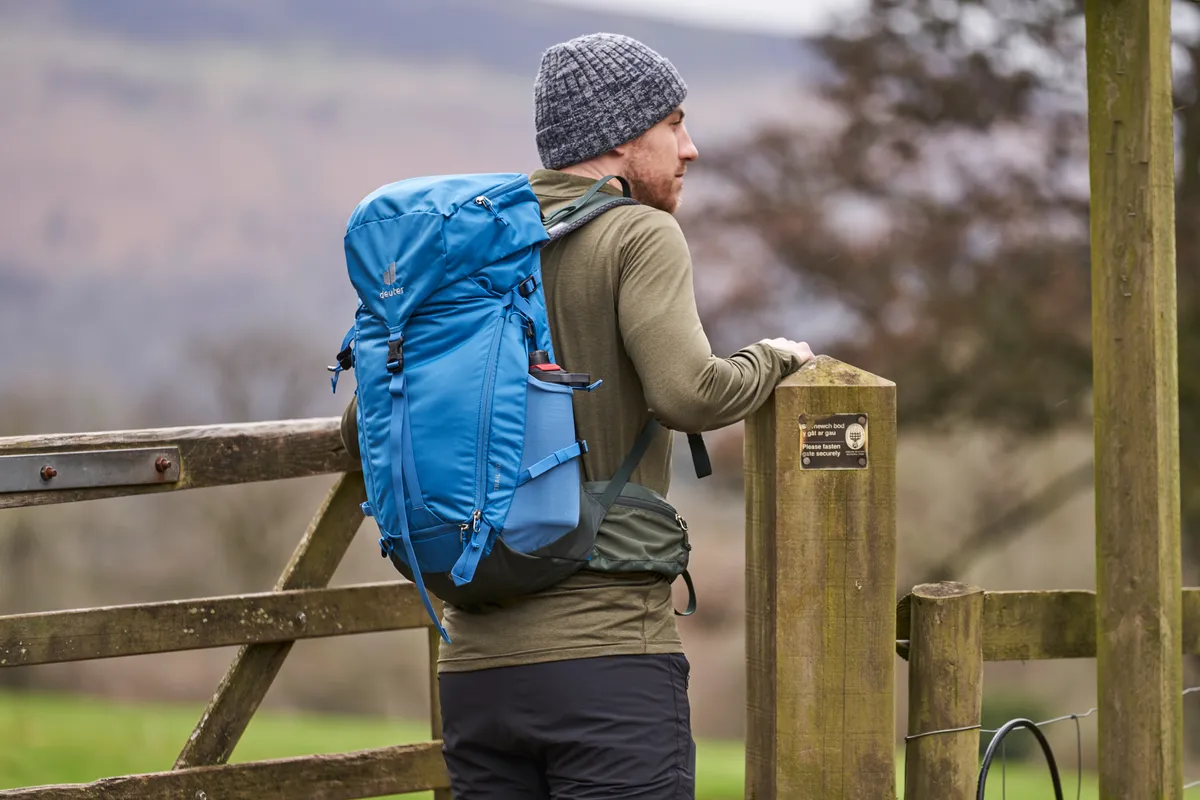
- Rain cover? Yes
- Hydration bladder compatible? Yes
- Hiking pole attachments? Yes
- Whistle? No
- Weight: 1070g
Before we get into the tech specs, it’s worth noting the Trail 30’s eco elements. Deuter says it’s completely carbon neutral and made from 100% recycled PET. There’s also a long front zip, which sets the Trail 30 apart from other daypacks we’ve tested. Thanks to this clever feature, reaching items stored at the bottom is easy.
Admittedly, the foam back panel isn’t as comfortable as it would be if it used a trampoline-style system, but it does allow for reasonable ventilation, thanks to the central channel. If you don’t mind the panel, the Trail 30 makes a great option for summer and winter day hikes.
Pros: Front zip access, strong list of features, very good pole/axe attachments
Cons: Back panel isn’t as comfortable as others, side pockets may not fit large bottles
Read our full review of the Deuter Trail 30
SQUIRREL_13077026
Deuter Speed Lite 17
SQUIRREL_TEXT_13077012

- Rain cover? No
- Hydration bladder compatible? Yes
- Hiking pole attachments? No
- Whistle? No
- Weight: 420g
- RRP: £62
With a 420g weight, 17L capacity and £62 RRP, this Deuter Speed Lite is the lightest, smallest and cheapest pack we tested here. It’s a great budget-friendly option for casual walks in low-level settings.
There’s no rain cover, whistle or walking pole attachments, but there is space to fit a 2L hydration reservoir, as well as a zip-up compartment and elasticated water bottle pockets on each side.
Where this pack falls down slightly is its lack of support across the back panel. The thin mesh sits flush to your skin, and there’s no padding in the detachable hip belt so carrying heavy loads can be uncomfortable.
On the plus side, the backpack is made with recycled pre-consumer waste for sustainability.
Pros: Lightweight, good value
Cons: Thin back panel, light on some features
Read our full review of the Deuter Speed Lite 17
SQUIRREL_13077012
Patagonia Altvia 22L
SQUIRREL_TEXT_13077317
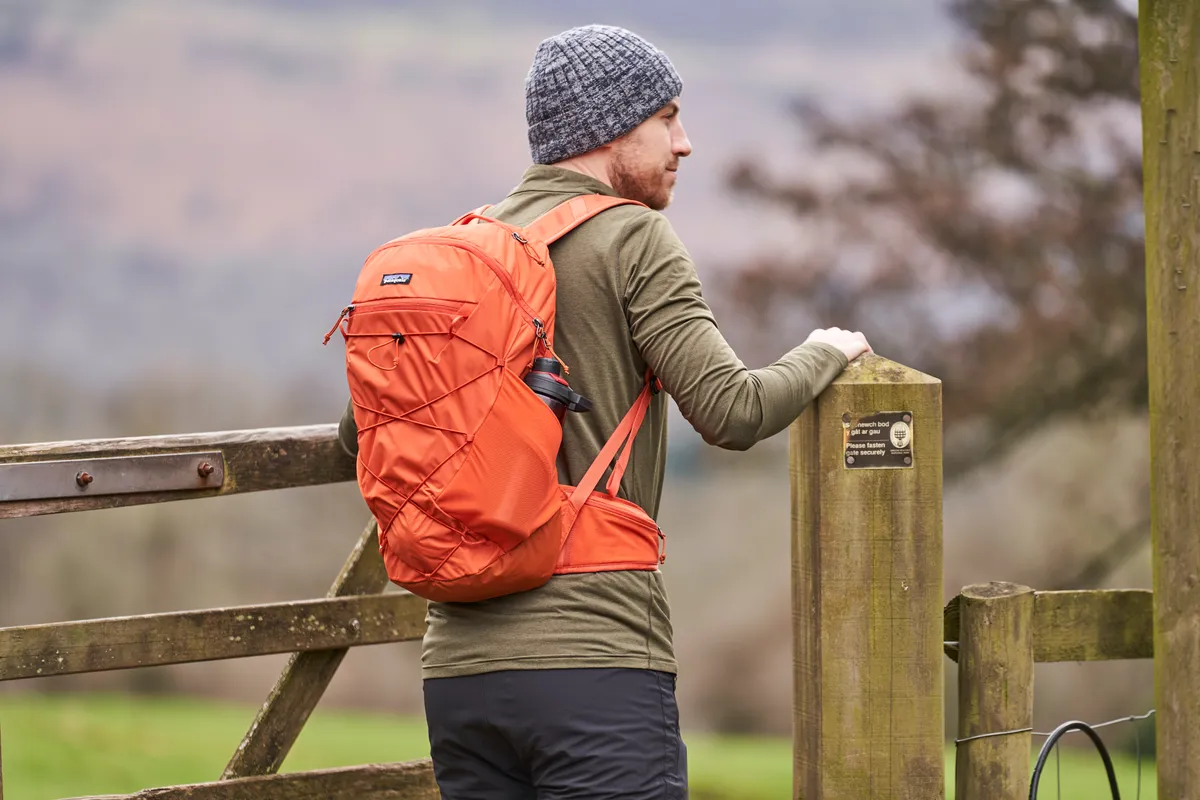
- Rain cover? Yes
- Hydration bladder compatible? Yes
- Hiking pole attachments? No
- Whistle? No
- Weight: 670g
- RRP: £109.95
Patagonia’s Altvia 22L shares many features with the Deuter Speed Lite 17 also on test here – although the former is almost £50 more expensive. It’s slightly larger, with enough space to accommodate kit for day hikes and low-level walks, but might struggle on winter mountain walks.
Happily, the Altvia has a more structured back panel than the Deuter, though it could be slightly more adjustable. The main compartment, zip pocket and bungee cord provide fine storage, but we did find water bottles tend to slide out of the shallow side pockets when crouching down.
Pros: Lightweight, comfortable
Cons: No adjustable back, side pockets are a bit shallow
Read our full review of the Patagonia Altvia 22L
SQUIRREL_13077317
Mountain Warehouse Pace 30L
SQUIRREL_TEXT_13077002

- Rain cover? Yes
- Hydration bladder compatible? Yes
- Hiking pole attachments? Yes
- Whistle? No
- Weight: 870g
- RRP: £69.99
If you’re after a budget-friendly daypack, you could consider Mountain Warehouse’s Pace 30. It has enough space to store extra layers, food and emergency supplies, and features a long zip so you can easily grab items stashed halfway down the pack.
It’s made with a breathable trampoline-style back system, but the padding on the shoulder and hip straps is fairly basic compared to other options on test here. As you might expect from the price, the construction did feel somewhat cheap, and the zip wasn’t particularly smooth.
We did appreciate the walking pole/ice axe attachments, rain cover and hydration reservoir pouch.
Pros: Long feature list, good value
Cons: Finishing, basic hip and shoulder straps
Read our full review of the Mountain Warehouse Pace 30L
SQUIRREL_13077002
Osprey Manta 34L
SQUIRREL_TEXT_13081812
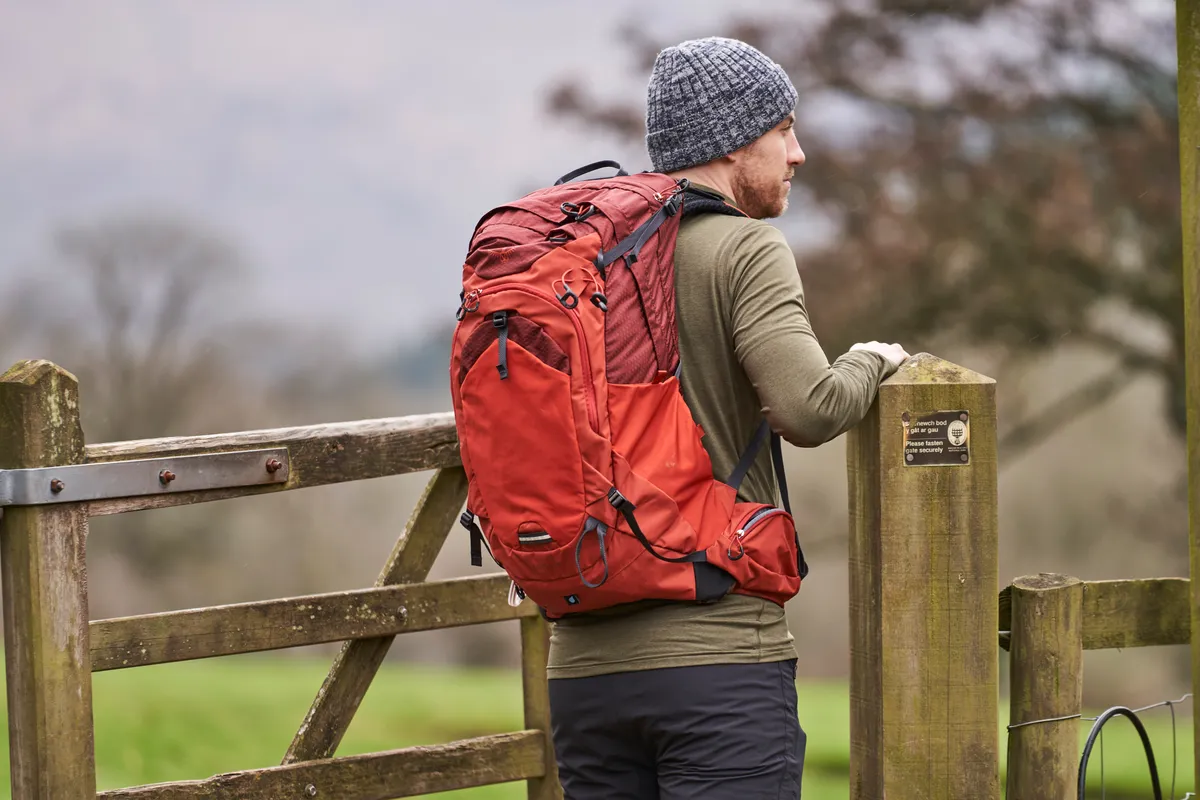
- Rain cover? Yes
- Hydration bladder compatible? Yes, and one comes with the pack
- Hiking pole attachments? Yes
- Whistle? No
- Weight: 1,440g
- RRP: £179.90
Osprey’s Manta 34L may be the heaviest daypack here but the payoff is a 34L capacity and huge selection of clever features. It’s probably overkill for casual walks but fit our full winter kit list with room to spare.
There are plenty of storage compartments, including side pockets large enough to fit big water bottles. You get a handy rain cover as well, and two separate walking pole attachment points.
A solid frame structure and the all-important trampoline system with multiple adjustment points makes for a comfortable walking experience. Plus, the main body and bottom of the pack use recycled materials.
Pros: Packed with features, incredibly comfortable, great organisation
Cons: Not cheap, may be overkill for day hikes in milder weather
Read our full review of the Osprey Manta 34L
SQUIRREL_13081812
Osprey Hikelite 28
SQUIRREL_TEXT_13077050
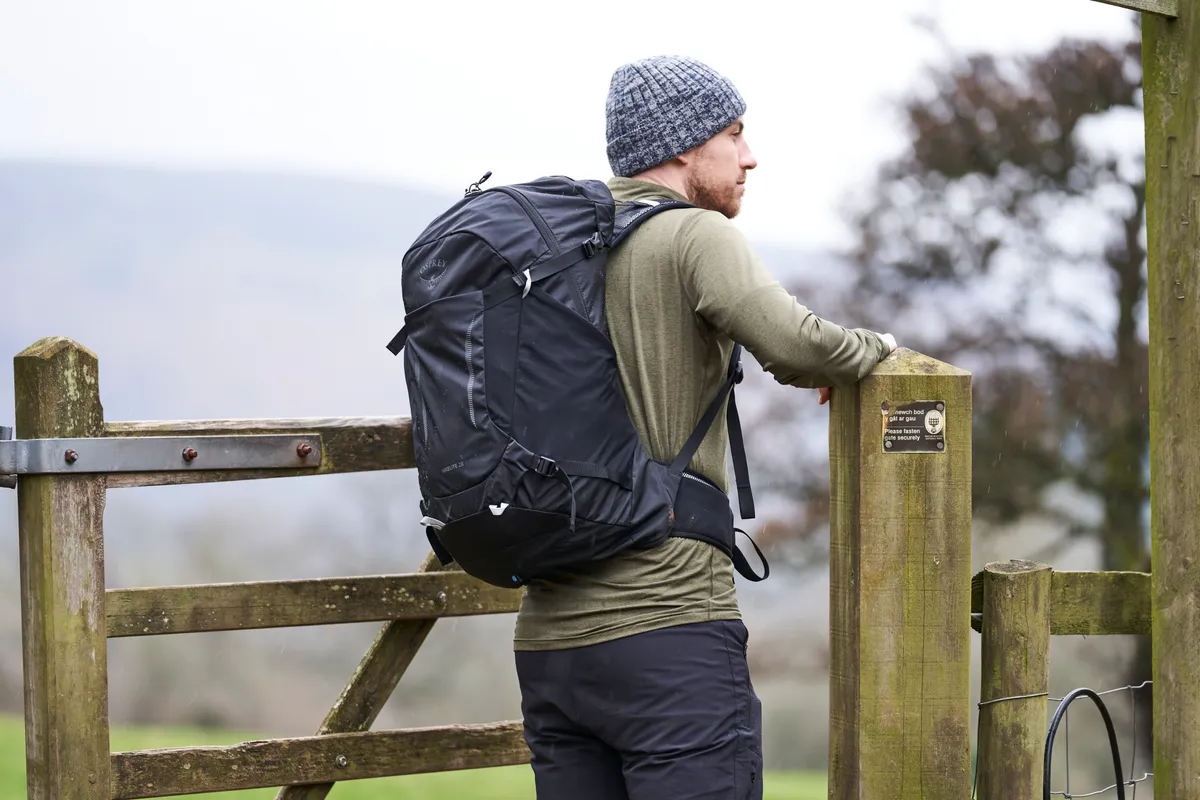
- Rain cover? Yes
- Hydration bladder compatible? Yes
- Hiking pole attachments? Yes
- Whistle? Yes, on sternum strap
- Weight: 990g (size M/L)
- RRP: £124.99
For a 990g pack, Osprey’s Hikelite has a great back harness and plenty of extra features. We could fit a full winter kit list inside, and appreciated the long zip stretching halfway down the bag.
A special mention should go to the elasticated side pockets, which are big enough to fit two water bottles each, but still secure enough to stop anything falling out when crouching down.
The breathable trampoline-style harness, rain cover and walking pole attachment points also make this pack a practical choice. There’s even a built-in whistle and room for a hydration reservoir.
Pros: Feels lightweight, fantastic set of features, comfortable
Cons: Has a wide silhouette when fully loaded
Read our full review of the Osprey Hikelite 28
SQUIRREL_13077050
Cotopaxi Luzon 24L daypack
SQUIRREL_TEXT_13077039

- Rain cover? No
- Hydration bladder compatible? No
- Weight: £65.00
- RRP: 420g
Renowned for its bright, eye-catching designs, Cotopaxi is a popular choice for those looking for a sustainably-made, good-looking backpack. The Luzon 24L is a comfortable pack, thanks to the ultralight mesh shoulder straps.
We had no issues with wear and tear on review, and we were impressed with the pack's internal organisation, with plenty of zipped pockets and compartments to keep belongings separated.
We wouldn't say it's the most practical design for wet weather adventures however, as the pack features an exposed top drawstring closure. You'll need a waterproof cover to hand if you're heading out in all conditions.
Pros: Striking design, sustainably-made, excellent internal organisation
Cons: Drawstring closure is impractical for wet weather
Reviewed by Rachel Howatson
Read our full review of the Cotopaxi Luzon 24L daypack
SQUIRREL_13077039
Jack Wolfskin Aerorise 40
Buy now from Jack Wolfskin (£400.00 £320.00)
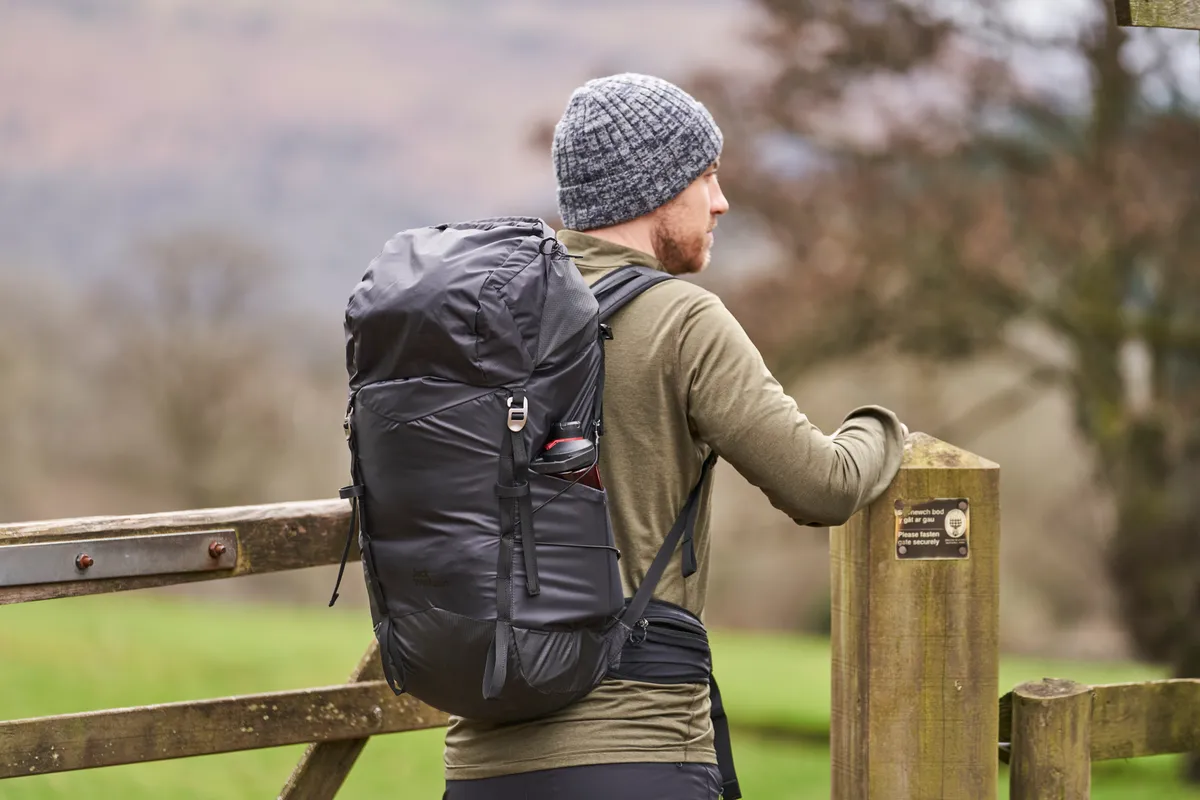
- Rain cover? No, but waterproof lining
- Hydration bladder compatible? Yes
- Hiking pole attachments? Think so
- Weight: 890g
- RRP: £400
With a price tag of £400, it’s fair to say the Aerorise 40 is one of the more expensive options available. Using 3D-printed back panels, it aims to offer good ventilation as well as vital support and load control. Jack Wolfskin says it can reduce back temperatures by up to 5°C, and while it does feel cooler, it isn’t always as comfortable as a trampoline-style system would be.
Other features include a waterproof inner, bungee cord and whistle. Although there are walking pole attachment points, the Velcro loops are too close together to be secure, and they’re removable, so easily lost.
While we feel the performance doesn’t quite fit the price tag, the Aerorise 40 does offer some innovative features.
Pros: Waterproof liner, slimline design is good for scrambling
Cons: Huge price tag, hard to find items inside
Read our full review of the Jack Wolfskin Aerorise 40
SQUIRREL_13111355
How to find the perfect backpack – a buyer's guide
How big a pack do I need?
Backpack-makers tend to measure the volume of their packs in litres. This usually appears in the backpack's name: for example, Osprey's Hikelite 26 contains 26 litres of space.
Think about what you’re going to be using the pack for. If you’ll only be using it for low-level summer walks, then you can get away with a capacity down to 15 or even 10 litres.
Alternatively, if you’re going higher and venturing into mountainous terrain (or being loaded up by the family), you’ll need a larger walking backpack that will swallow multiple layers, accessories and safety equipment. In these scenarios, try to aim for 25-35 litres.
That sort of capacity can also be enough if you plan to walk in winter, though you may even want to venture up to 40 litres.
What are the best rucksacks for day walks?
We covered the ideal day backpack volumes at the top of this article, but here's a quick recap:
- The ideal daypack might have a volume of between 18L and 35L - if all you're carrying is a rain jacket, a water bottle and a spot of lunch, 18 litres will probably do it
- Many day-walkers would prefer the flexibility of a slightly larger pack with a litre-rating in the mid-20s
- Those who tend to lug a bit more around – the picnickers, beach lovers, Munro-baggers, bothy-lovers or winter hikers – might prefer something around 30 or even 40 litres
Best backpacks for multi-day hikes
Multi-day hikers split into two camps. If you are travelling from inn to B&B, you may get by with a backpack volume between 35 litres and 45 litres. That should be enough space for all the normal day walking gear, plus a change of clothes and a wash bag, a book and whatever other essentials you might need.
But backpackers who plan to camp will usually need 60L or more for a sleeping bag, sleeping mat, tent and stove, as well as extra food.
Of course – it depends on your gear. Minimal backpackers happy to invest in often expensive ultralight gear might squeeze everything into a 50L pack; but if you are improvising with standard (and more affordable) gear, you'll need a 65L or even 70L pack.
Should you opt for a larger pack?
Whether you are shopping for a daypack or an overnight backpack, it can pay to err on the side of generosity when it comes to volume. You want to fit all your essentials; and there are often extra things to add that you might not have thought of. You don't want to end up relying on extra bags for overflow. Worst case scenario, you'll end up looking like the mule in Buckaroo.
If you do opt for a larger pack, you'll need to be disciplined when you pack – try not to cram your pack with stuff you don't really need, just because you have the extra space.
If the thought of opting for a larger volume backpack, only to end up with a half-load, puts you off, remember that most packs include compression straps, which can be tightened to keep your pack neat-looking, compact and stable on your back.
How comfortable is the pack?
Comfort is the single most important consideration, and covers many elements of the pack's design. Daypacks may be relatively small, but by the time you have added water, flask, food and other essentials, you may end up carrying a significant weight.
A heavy payload is the real test of a pack’s comfort. After a long day on the trail, that weight can really start to stiffen your shoulders and press down on your hips. Your pack really does feel twice as heavy as it did when you set out.
Here's what to look for as you try to figure out how comfortable the packs in your shopping trolley might be.
Does it fit?
Packs are adjustable, but there are limits. It may be stating the obvious, but our shapes vary. The different lengths of human backs is probably the hardest challenge for pack designers. So a pack that feels comfortable on me may dig into your hips or chafe on your neck. The solution is to try before you buy, or if you are buying online, always be prepared to return a pack that doesn’t fit, even if you heart was sold on it.
Some packs have backs of fixed length; others are adjustable. You may be lucky and find that a fixed length pack fits you perfectly. After all, even fixed length packs can be adjusted in various ways – at the waist and over the shoulders – to improve fit. But adjustable backs make it more likely you will achieve a good fit.
Check out the belt and harness
Look for foam padding on the shoulder straps and belt – it tends to soften the load. Belts move much of the burden on to your hips, taking the strain off your shoulders. Useful even in relatively small daypacks, they are a crucial part of a large backpack.
Fit is important – the belt ought to sit at the top of your hip bones; make sure the pack can be adjusted so the belt does not fasten below your hips or high over your stomach (more on this below). A wide belt spreads the load more effectively, but may get sweaty in hot weather.
What kind of frame?
Frames, usually at least part made of metal, hold the load more rigidly in place, and help transfer more of the burden to your waist via the harness and belt, which takes the pressure off your shoulders. They can also be used to improve ventilation. On the other hand, they tend to add weight – though some frames are much heavier than others.
Is ventilation good?
In warm weather, or on strenuous uphill hikes, a pack can get very hot and sweaty, especially where it touches your back. Pack-makers deploy various tactics to keep your back feeling cooler and drier. Mesh fabric absorbs moisture and allows some cooling air to move over your skin. Strategic foam pads reduce the surface area in direct contact with your back. The most sophisticated packs often feature mesh membranes held taut in a frame; these create a cavity between your back and the load, which allows more air to move over your back.
How heavy is your empty pack?
Some packs weigh much more than others when empty. If you want to keep the load light, bear that in mind. But remember that a really comfortable pack may weigh more when empty, but actually feel much lighter, because the load is spread so well over your body.
Storage
Are the external pockets well designed?
What kind of pockets are on the outside of your pack? A stretchy or otherwise easy-access large central pocket is essential for wet-weather gear.
Side pockets are ideal for water bottles, but check the bottles be easily secured in these pockets – or they will they fall out (see our favourite hiking water bottles if you need a new one!).
Finally, many packs now include zip pockets on the belt, which can be very useful for the bits and pieces you want to have handy on the move – sunglasses, snacks, suntan lotion and so on. The bigger these belt pockets the better!
Finally, one day someone will design a pack with a really large top pocket – the one that forms the ‘lid’. Invariably these are a bit too small for the many thing you might want to keep there.
How easy is it to get in the main compartment?
When you want to dig something out of your pack, is there a way to access the main storage pocket – the ‘sack’ in rucksack – other than going in from the top?
The best packs have one or more additional openings in the main compartment, so if you’re trying to get something out of the bottom, you don’t have to remove all the gear above it first.
Other useful features
Once you’ve assessed your needs for the above, you can start thinking about features.
Is there a good range of pockets to allow for clever organisation? Are there secure pockets for water bottles and an option to add a hydration reservoir?
As well as the provision for hydration and organisation, we also like to see things like attachment points for walking poles, a built-in whistle for safety, a waterproof rucksack cover to keep your kit dry (though we always advise using dry bags, too, to be safe) or even an attachment point for an ice axe if you’re planning to hike in winter.
Does the pack have a rain cover?
Hardly any daypacks claim to be waterproof. Before you buy, check your pack include a free rain cover – a removable waterproof cover, usually tucked into a pocket.
But to be really sure of keeping contents dry, keep the pack contents in waterproof dry bags – or the budget option, plastic bags or refuse sacks.
Is the pack hydration system compatible?
The easiest way to keep drinking water on the trail is to use what is grandly called a hydration system: invariably a flexible plastic bottle or ‘bladder’ (bought separately) that is stowed in a special sleeve inside your pack, with a drinking tube that hooks on to your harness. This means that a drink of water is always to hand - and saves you having to take off your pack and dig out a water bottle every time you want a drink.
If you want to use one, check that the pack is ‘hydration system compatible’ – it will need a sleeve inside the pack for the bottle, a perforation where the tube exits the pack, and some kind of attachment on the harness for the tube. Most modern backpacks include these features.
Check for hiking pole loops
Even if you like walking with hiking poles, you may not want to use them all the time. When you think they’ll be out of action for long periods, they are best attached to the back of your pack. Most walking packs now have fixings for them; how easy to use are they?
look out for packs that also have fixings for poles on the shoulder harness, where they can be easily attached and removed when you need them, without stopping and removing your pack. This is a much more convenient place to stash them when you know you might need them again in a few minutes.
Safety extras
Is there a whistle?
When you are walking in remote areas, especially in hills, safety is crucial.
In the event of an accident, does your pack have a built-in whistle to alert nearby rescue services? Many now include a buckle with a built-in whistle on the harness.
What about ice axe loops?
If you plan winter walks on snowy peaks, an ice axe is an essential piece of safety kit. If you slip, an ice axe is the best way to stop yourself sliding down the slope. Many packs include external loops for carrying an ice axe.
Does it look good?
There's no doubt about it – looks are important. And not just in a superficial way. Choose a pack you think looks great and you're more likely to use it until the end of its natural life. That's a good way you keep your carbon footprint as small as possible.
Choosing a pack with the right look can really add to your perception of its versatility – and value for money. It’s all a matter of taste, of course, but some would rather not sport a technical-looking hiker’s pack on the bus. So if you are only buying one pack, shop for one you are happy to take anywhere.
And go for one a colour and style you think you'll still appreciate in a year or more.
Sustainability
Many fabrics used by outdoor companies contain harmful chemicals called PFCs. If a fabric is PFC-free, the maker will likely say so pretty clearly in the product specifications.
It’s also worth looking out for fabrics made from recycled polyester, which has a lower carbon footprint than virgin polyester.
Look out for the Bluesign logo – this is a sign that the materials have been produced in a more 'sustainable, resource- saving' way.
• Words by Joe Pontin, BBC Countryfile Magazine features editor
For rainy days, take a look at our guides to the best waterproof backpacks, or keep your tech safe with one of our favourite camera backpacks. You can also see our round-up of the best backpack rain covers for extra protection against the elements.
Need other walking kit? Check out our guides to the best walking boots, best walking shoes, best walking trousers, best walking socks, best walking sandals - and lots more.

